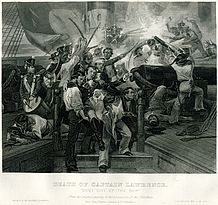Illustrator Chappel and Publisher Johnson
 Enlarge
Enlarge
In the earliest collaborations between publishers and artists in the pictorial history market, the latter had often felt subordinate to the former. By mid-century, however, publishers like Johnson had become increasingly dependent on book illustrators whose talents were more important to the financial success of gift-books than had been the case in Frost’s time. As the use of pictorial evidence became more accepted and desirable and skilled engravers began to earn upward of $250 a plate for steel-line engravings, they often commanded most of the operating budget for a work like History of the United States. Johnson’s engravers were so vital to the illustrating process that they began cutting their names or initials into the burnished plates used to illustrate his books, indicating their co-ownership of the publisher’s pictorial products. [61]
Cost-conscious publishers such as Benjamin Walker had appropriated for use in pictorial histories images that were readily available and not protected by copyright. Johnson, however, was anxious to hire an illustrator who would “pictorialize” his text specifically—either someone with an established portfolio of portraits and historical paintings whose works could be adapted to the pictorial history or an artist who could create original, monumental images produced expressly for the History of the United States. The distinction was between someone who was an “illustrator” in the broadest sense of the term—that is, one who created pictorial originals from the historical imagination—and someone who performed the explicative function of “illustrating” another’s words. [62] He found both in Alonzo Chappel.
By the end of the 1850s, the largest collection of original Alonzo Chappel paintings was at the offices of Henry J. Johnson, who hired the painter to translate his canvases into illustrations for Spencer’s pictorial history. Johnson admired Chappel’s highly iconographic visual representations which emphasized the same heroic values of strength, leadership and courage promoted in Spencer’s manuscript, and they developed an editorial plan to illustrate the text in a manner consistent with its high moralizing tone. For instance, Johnson decided on full-page steel engravings for the History of the United States, printed on special paper and protected by liners, giving the illustrations grandeur appropriate to Spencer’s purposes. [Image 43] Johnson employed the steel engraving process primarily as a way to reduce the details of large, stately, allegorical paintings to a size suitable for standardized books, reproducing in miniature those forms previously restricted to large canvases.
The ability of steel engraving to allow for dramatic reductions of scale without loss of detail encouraged the mass circulation of monumental history painting. Hence, while history painting in the grand manner had reached its peak as an exhibition phenomenon in the early decades of the nineteenth century, accurate steel engraving reproductions of the sort Chappel produced encouraged a renaissance of sorts for such images at mid-century. Johnson hoped to benefit from this revival by wedding Chappel’s monumental vision with the highly principled imperatives of Spencer’s History of the United States, creating a richly textured visual and literary history suitable for readers in need of moral regeneration at the end of the 1850s.

